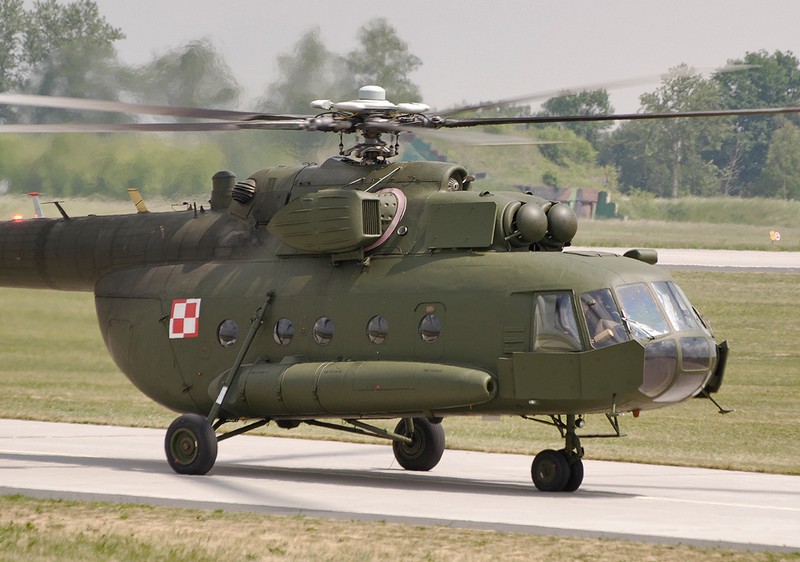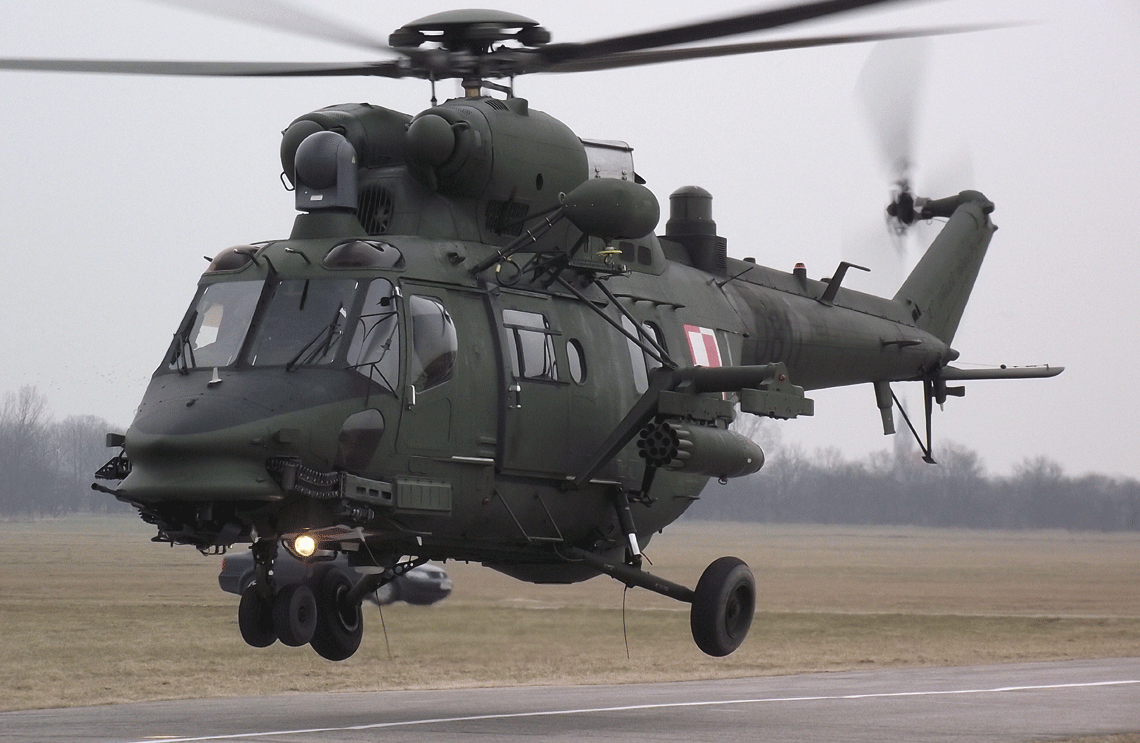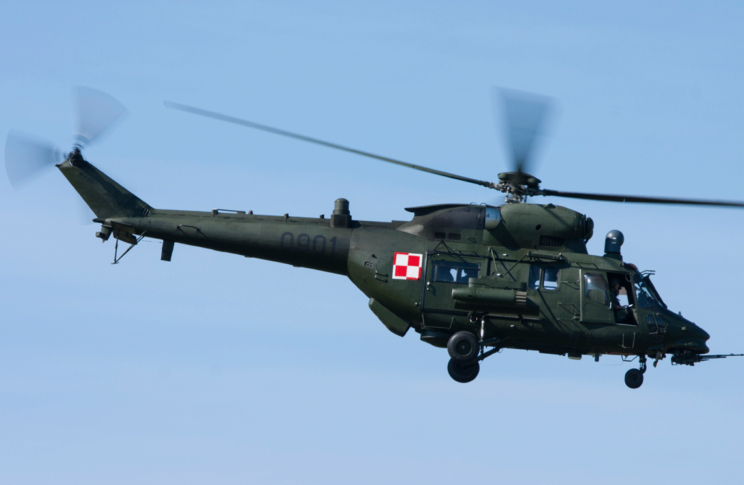
Polish reconnaissance helicopters part 2

W-3PL Głuszec approaching landing at Nowy Targ Airport after flying in the mountains. During the modernization, helicopters of this type were retrofitted, including with optoelectronic heads installed between the engine air intakes.
In January 2002, the defense ministers of Poland, the Czech Republic, Slovakia and Hungary expressed their desire to jointly modernize Mi-24 combat helicopters and bring them into line with NATO standards. The work was to be carried out by Wojskowe Zakłady Lotnicze No. 1. The program was codenamed Pluszcz. In February 2003, the tactical and technical requirements for the upgraded Mi-24 were approved, but in June 2003 the program was terminated by an intergovernmental decision to suspend work on the joint modernization of helicopters. In November 2003, the Ministry of National Defense signed an agreement with WZL No. 1 to develop, together with Russian and Western companies, a modernization project and the preparation of two Mi-24 prototypes that meet the tactical and technical requirements of Plyushch. program. 16 helicopters were to be modernized, including 12 into the Mi-24PL attack version and four into the Mi-24PL/CSAR combat rescue version. However, this contract was terminated by the Ministry of Defense in June 2004.
Troubles in the Pluszcz program prompted attention to the W-3 Sokół battlefield support helicopter. The main goal of the modernization program, however, was not to equip rotorcraft of this type with anti-tank guided missiles, but to increase the amount of information owned by the crew, and to enable reconnaissance missions and the transfer of special groups in all weather conditions, day and night. The program was officially launched on October 31, 2003, when the Defense Policy Department of the Ministry of National Defense signed a contract with WSK "PZL-Świdnik" to develop a conceptual design. In addition to the plant in Swidnica, the development team included, among others, the Air Force Institute of Technology and, on the basis of a cooperation agreement, the Research Center for Mechanical Equipment in Tarnow.
In April 2004, the project under the designation Głuszec was approved by the Ministry of National Defense. In the autumn of the same year, a contract was signed for the production of the W-3PL Głuszec prototype and for its testing. In mid-2005, the Department of National Defense added a requirement that the W-3PL also be adapted for combat rescue missions. Two W-3WA helicopters used by the Polish Army were chosen to build the prototype; These were examples with tail numbers 0820 and 0901. The choice of this version was not accidental, because the W-3WA has a dual hydraulic system and meets the requirements of FAR-29. As a result, 0901 was sent for reconstruction to Svidnik. The prototype was ready in November 2006 and took off in January 2007. Factory tests continued until September. Qualification (state) tests started in autumn 2008. Positive test results were immediately issued by order of the Ministry of Defense. The cost of the contract, including the implementation of the program, is estimated at PLN 130 million. At the end of the year, a contract was signed for the construction of the first batch of three helicopters, and work began almost immediately. As a result, at the end of 2010, both prototype 3 and three contracted W-56PLs with tail numbers 0901, 3 and 0811 were transferred to the 0819th combat and rescue squadron of the 0820th combat helicopter regiment in Inowroclaw.
The upgraded combat support helicopter W-3PL was equipped with an integrated avionics system (ASA) developed at the Air Force Institute of Technology. It uses a modular MMC mission computer based on MIL-STD-1553B data buses, which transmit, among other things, with subsystems such as communications, identification and navigation or surveillance and intelligence. In addition, ASA, in cooperation with ground equipment, allows for pre-flight planning of tasks, taking into account such elements as the flight route, targets to be destroyed or reconnaissance, the use of combat assets and on-board systems, and even its implementation. Information such as turning points (navigation), main and reserve airports, the location of friendly troops, objects and equipment, and even a photograph of a specific object is also loaded into the system's memory. These data can be modified in flight as the tactical situation in the area of interest changes. The above information is marked on the map, which allows you to display the territory within a radius of 4 to 200 km. Zooming is done automatically when the crew determines the area of interest. The map is constantly oriented in the direction of flight, and the position of the helicopter is displayed in the center of the map. Also during debuffing, the system that analyzes data using the S-2-3a recorder allows you to read flight parameters, visualize the route (in three dimensions), and also recreate the image recorded in the cockpit during the mission, which allows for an accurate assessment of the mission , including exploration results.

W-3PL Glushek in flight. The car was a prototype of modernization. After positive testing, three more W-3 Sokół (0811, 0819 and 0820) were rebuilt to this version.
The W-3PL has an integrated navigation system (ZSN) that forms the Thales EGI 3000 system, integrating an inertial platform with a GPS, TACAN, ILS, VOR/DME satellite navigation system receiver and an automatic radio compass. ZSN complies with ICAO requirements for radio navigation and landing systems. On the other hand, the Integrated Communications System (ZSŁ) includes four HF/VHF/UHF radios operating in the 2-400 MHz band. Their task is to ensure constant communication between their crew (intercom + listening to special navigation and warning signals), including with the operational group on board or a doctor, as well as with troops on the ground or with a reconnaissance command post, as well as downed personnel ( mission of combat rescue). ZSŁ has four modes of operation: Explicit Communication, Voice Encrypted Communication (COMSEC), Frequency Stepping Communication (TRANSEC), and Automatic Connection Communication (ALE and 3G).
